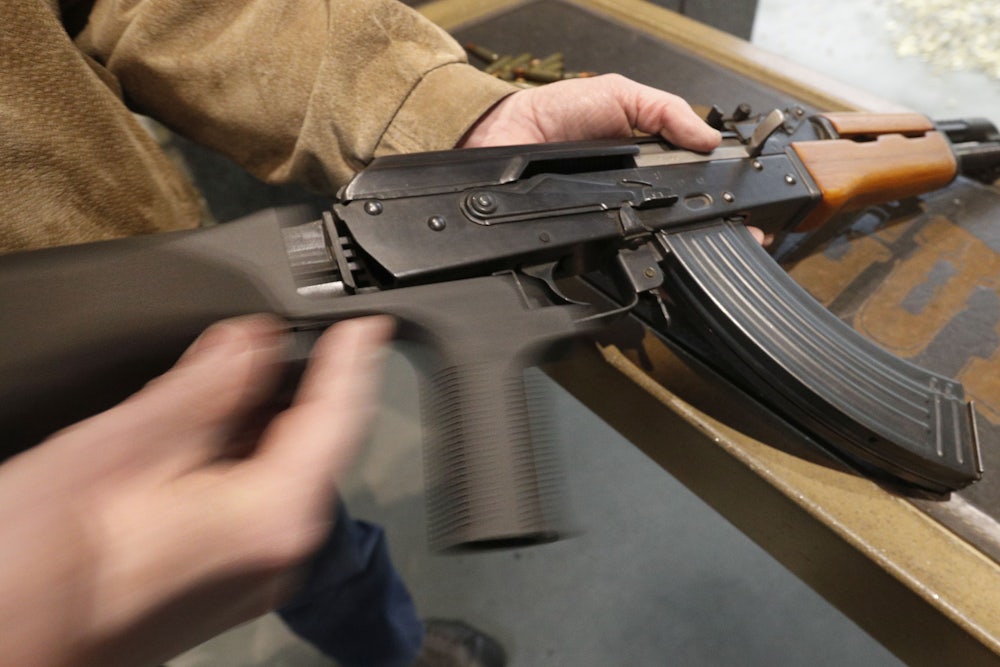Few things are guaranteed at the Supreme Court. The justices can almost always choose to hear or not hear certain cases, to rule or not rule on certain questions, and to decide or not decide specific matters. This usually means they don’t act. But in an upcoming gun case heading their way, they might not have much of a choice in the matter.
Five years ago, the federal government banned the sale of bump stocks for semiautomatic rifles after they were used to carry out a massacre in Las Vegas. A number of gun rights activists and groups have since sought to overturn that ban. They persuaded the Fifth Circuit Court of Appeals earlier this year to side with them, creating a split among the federal courts. Now both the federal government and the gun rights groups want the justices to resolve the dispute. The court has relisted it for discussion in its privately weekly conferences multiple times, according to the dockets—this past week being the most recent occasion.
At issue in the two cases—Garland v. Cargill and Guedes v. ATF—is what counts as a “machine gun” under federal law. This question is not as easy to answer as it sounds. A machine gun is best understood as any gun that can fire its supply of ammunition continuously with a single, sustained pull of the trigger. While these guns are often described as “automatic weapons,” that term can obscure more than it clarifies, especially where bump stocks are concerned.
An “automatic” weapon typically has two features: automatic fire and automatic reloading. This distinguishes it from a single-action firearm, where the user has to manually reload it to fire again. (Think Colt revolvers from the Old West and in cowboy movies.) It also distinguishes it from a “semiautomatic” firearm, which uses the energy from firing one round to automatically reload the next round but still requires another pull of the trigger to fire again.
Machine guns are rare in modern American life for two reasons. The first is that they are impractical. The attribute that defines a machine gun—the continuous and uninterrupted rate of fire—makes them useful for military purposes where sustained fire can serve a tactical purpose. But it is not so helpful for hunting, sporting, or self-defense, where semiautomatic rifles and pistols allow for greater control and accuracy. (You also save a lot of money on ammunition, which is more important for the average gun owner than it is for the Department of Defense.)
The second reason is that machine guns are strictly regulated in the United States. They are not illegal to own outright, though many people think they are. The National Firearms Act of 1934, or NFA, established a series of restrictions and taxes on the purchase and ownership of certain firearms that Congress associated with crime. It also created a registry for lawfully owned machine guns, which were subject to various licensing requirements and other conditions.
The NFA also provided the first and current legal definition of what counts as a machine gun. Congress defined one as “any weapon which shoots, is designed to shoot, or can be readily restored to shoot, automatically more than one shot, without manual reloading, by a single function of the trigger.” The full definition also covered any components that can be used to easily build a machine gun, as well as “any part designed and intended solely and exclusively, or combination of parts designed and intended, for use in converting a weapon into a machine gun.”
Congress closed that registry in 1986, meaning that only the individual machine guns that were registered before that date can be lawfully purchased and owned by civilians today. This placed machine guns out of reach for most people. Not only are they impractical and excessive in their own right, but the artificially constrained supply means they are pretty expensive as well. Most of them survive today as antiques, collectors’ items, or family heirlooms.
Enter the bump stock. As I noted earlier, a “fully” automatic firearm has automatic reloading and automatic fire, while a “semi” automatic firearm has automatic reloading after each round but still requires the user to pull the trigger to fire again. A bump stock replaces a semiautomatic rifle’s existing stock—the thick part that rests against your chest when you aim it—with a partially moveable one. With a bump stock, the recoil from firing one round “bumps” the user’s finger against the trigger and fires it again. This converts a semiautomatic rifle into something approximating a fully automatic one.
While bump stocks have existed for more than two decades, they received little public attention before they played a role in the deadliest mass shooting in American history. In 2017, a gunman rented rooms at the Mandalay Bay casino in Las Vegas that overlooked a country music festival. Over a roughly 10-minute span, he used a variety of weapons—including some semiautomatic rifles equipped with bump stocks—to fire more than 1,000 rounds into the gathered crowd. He ultimately killed 60 people and wounded 800 others before dying by suicide before police could apprehend him.
The Bureau of Alcohol, Tobacco, and Firearms, which is responsible for the NFA machine gun registry, had previously concluded that some bump stocks did not fall under the law’s definition of machine gun parts. After the Las Vegas shooting, however, it changed course as the devices came under considerable criticism and scrutiny. Even the National Rifle Association said after the shooting that it believed that bump stocks should be “subject to additional regulations.” The new ATF rule, which defined all bump stocks as machine gun parts, went into effect in 2018.
The plaintiffs in these cases are gun owners who possessed bump stocks before 2018, as well as the gun rights groups that support them. They argue that the ATF rule is based on a misreading of the NFA’s definition of a machine gun and therefore must be overturned. Only Congress, they argue, has the power to amend that definition to cover bump stocks. To challenge the ATF’s reading of the NFA, the plaintiffs zeroed in on the definition’s use of the phrase “single function of the trigger.”
“A weapon is defined as a ‘machine gun’ if but only if ‘a single function of the trigger’ can cause the weapon to shoot ‘automatically,’” the plaintiffs in Cargill told the justices. “The plain meaning of that sentence is that a weapon is not a ‘machine gun’ if something more is required of the shooter than a single function of the trigger to produce more than one shot. And, as the final rule concedes, the shooter must do considerably more than pull the trigger once if he wishes the weapon to fire multiple shots.”
The federal government rejected that view, arguing that it ran counter to how bump stocks actually work. “Once the trigger has performed its function of initiating the firing sequence, a bump stock ensures that the sequence will continue as long as the shooter maintains forward pressure on the front of the weapon with his non-trigger hand,” the Justice Department argued in its petition for review. “The trigger mechanism itself resets before each additional shot, but that process happens automatically by design.”
Previous challenges to the ATF rule failed to persuade three of the federal appeals courts. In the Guedes case, for example, the D.C. Circuit Court of Appeals ruled that the agency could regulate bump stocks under the NFA. “Under Plaintiffs’ strict understanding of the ‘single function of the trigger’ to mean the mechanistic movement of the trigger itself,” Judge Robert Wilkins wrote for the court, “this weapon would evade classification as a machine gun even though the shooter’s initial pull of the trigger causes an automatic series of trigger movements and a resulting automatic series of shots, without any further input by the shooter whatsoever.”
But the Fifth Circuit broke ranks with its brethren courts earlier this year by ruling in favor of the Cargill plaintiffs. In a fractured ruling, the judges on the court blocked the ruling on two grounds. Some of the judges concluded that the NFA definition unequivocally does not cover bump stocks. Others held that while the definition could arguably cover bump stocks, that ambiguity should be resolved in favor of the plaintiffs under the rule of lenity, which normally applies to criminal prosecutions. The net effect was that the Fifth Circuit ruled that Congress, not the ATF, must be the one to ban bump stocks.
“Indeed, the Government would outlaw bump stocks by administrative fiat even though the very same agency routinely interpreted the ban on machine guns as not applying to the type of bump stocks at issue here,” Judge Jennifer Elrod wrote for the court. “Nor can we say that the statutory definition unambiguously supports the government’s interpretation. As noted above, we conclude that it unambiguously does not. But even if we are wrong, the statute is at least ambiguous in this regard. And if the statute is ambiguous, Congress must cure that ambiguity, not the federal courts.”
The Supreme Court has largely unfettered discretion when deciding which cases it will and won’t hear. But one of the surest instances in which it takes up a case is when different federal courts read the same federal law in sharply different ways. The justices have previously declined to hear gun rights groups’ appeals in these cases, for reasons known only to them. This time, with both sides urging them to hear it, they may have little choice but to wade in.










